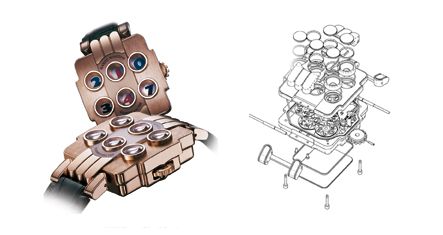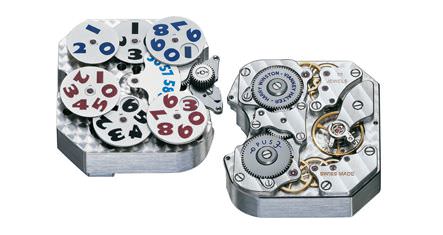
The Opus 3, as it was shown in 2003
The long awaited Opus 3 has finally arrived. As you will remember, this exceptional watch was designed in 2003 by Vianney Halter for Harry Winston’s famous Opus series. The prototype that was shown in 2003 created a sensation, and the watch soon became the talking piece of that year’s BaselWorld show.
The first watch with an entirely mechanical digital display, it has six windows. The hour is read horizontally in windows 1 and 3 of the upper row while the minutes are read in windows 4 and 6 of the lower row. The date is read vertically in windows 2 and 5. In addition, before each change of the hour or minute, the four last seconds are displayed one after the other in the first window.
This timepiece was a veritable revolution that allowed us to say, “with the Opus 3, Vianney Halter and Harry Winston have truly taken the haut de gamme by storm.” The only problem was that its production in quantity, even the limited quantity of 35 watches, encountered a number of problems, the most serious being the power required to give the necessary impulsions to the six discs to make them turn.

After a great deal of research, Harry Winston entrusted the final development of this mechanism to FrÉdÉric Garinaud, director of the Watch Specialties unit at Audemars Piguet and creator of the remarkable Opus 8.
Delving into the experience at Renaud & Papi, the ‘laboratory’ of Audemars Piguet, Garinaud used the movement created for the RM9 of Richard Mille as a base. Without touching the conceptual logic developed by Vianney Halter, he worked at minimizing the energy necessary to make the discs move. Two barrels were used, one independent of the movement and one connected to the movement. The latter activates the small third wheel, which then activates a lever that liberates the second barrel. A sort of chain reaction ensues, including the activation of the four last seconds, that liberate, in their turn, the passage of the minutes, which is coupled to the ten minutes function. This then is linked to the hour, which itself drives the date, and so on.
We will come back in more detail to the development of the Opus 3, and how this most remarkable watch of the decade finally saw the light of day.
Source: Europa Star April-May 2009 Magazine Issue





